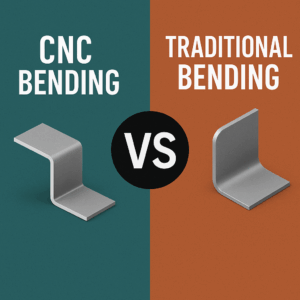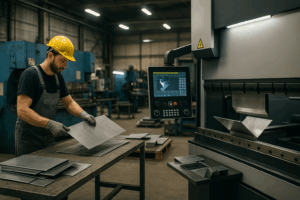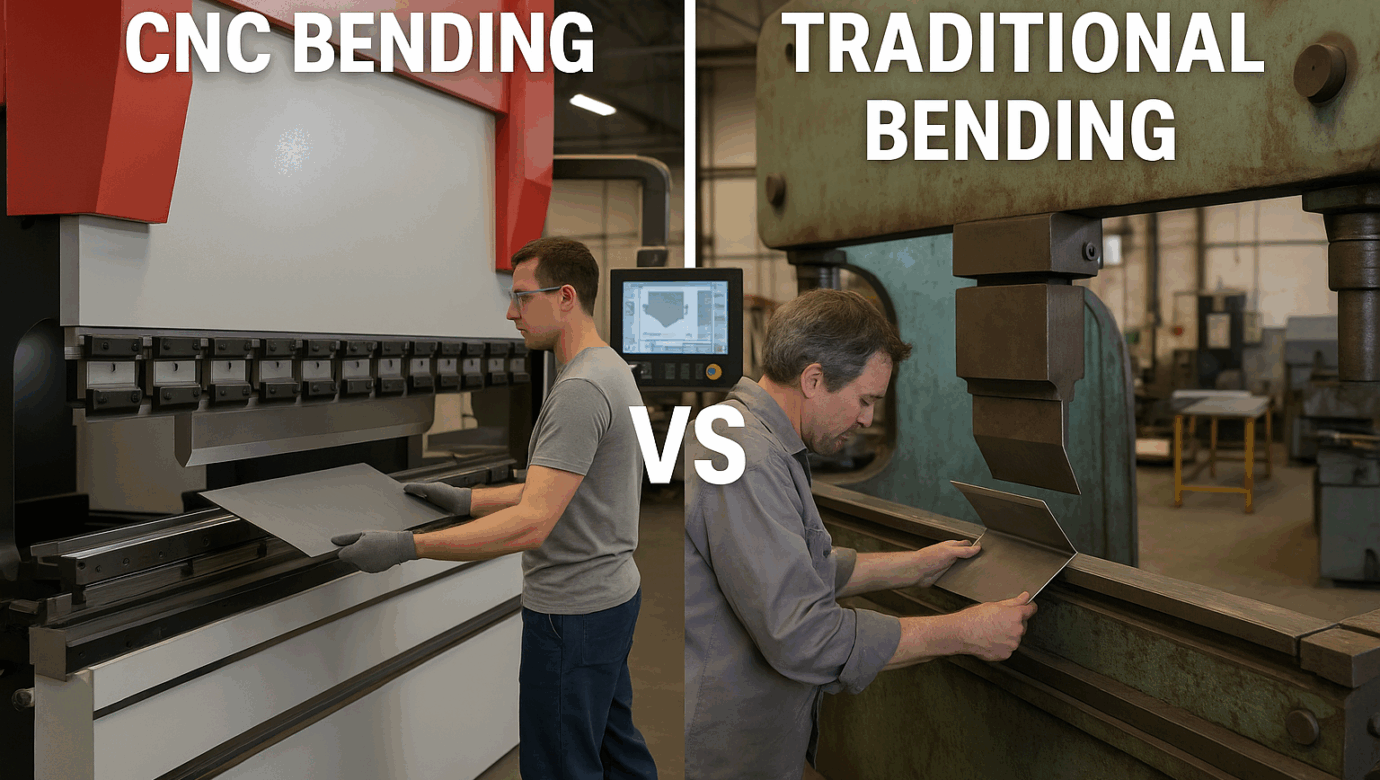Choosing Between CNC Bending and Traditional Methods: Which One Is Right for Your Project?
Imagine this: You’re standing in the heart of a fast-paced industrial workshop in the middle of Dubai. Sheets of metal are being formed into complex shapes—some through time-honored hand-controlled techniques, others with laser-precise automation. Which one delivers better results? Which one saves you time, cost, and mistakes?
In the world of metal fabrication, the debate between CNC Bending vs Traditional Bending isn’t just a technical one—it’s strategic. Whether you’re designing high-tech enclosures or large-scale architectural panels, how you bend metal can directly affect the quality, consistency, and timeline of your project.
At Morshedi Building Metal Products Manufacturing LLC, we’ve seen both worlds in action. With over 20 years of experience and a deep commitment to innovation across the GCC region, we help engineers, architects, and project managers choose the right approach—not just for bending metal, but for building trust in every millimeter.
In this in-depth guide, we break down the differences, advantages, limitations, and real-world applications of CNC Bending vs Traditional Bending—so you can make the smartest decision for your next project.
Before You Bend—Understand the Real Benefits
If you’re curious why CNC bending has become the go-to technology for engineers and project managers in modern construction, you’ll want to check out our article on Top 5 Powerful Benefits of CNC Bending and Tube Laser Cutting in Modern Construction. It breaks down how precision, speed, and design freedom can revolutionize the way your components come to life—especially when deadlines are tight and tolerances are even tighter.
What Is CNC Bending and How Does It Work?
CNC Bending vs Traditional Bending – it all starts with understanding what CNC bending actually is.
CNC bending, or Computer Numerical Control bending, refers to the automated process of bending sheet metal using a press brake that is controlled by a computer program. Unlike traditional bending, where an operator manually adjusts the machine and angles, CNC bending is highly precise and repeatable thanks to the use of pre-programmed data and servo motors.
At the heart of CNC bending is a press brake—a machine equipped with a punch and die. The metal sheet is placed between the two, and the machine exerts force to bend the sheet to the desired angle. But what makes CNC unique is its automated control system. Engineers input detailed specifications such as bending angles, radii, and sequences into a CAD/CAM system, and the machine executes them with minimal human intervention.
“Automation has revolutionized precision metalwork. CNC bending allows for high accuracy even in complex parts.”
— Metal Fabrication Journal, 2023
Compared to traditional bending, which relies heavily on operator experience, CNC systems reduce the risk of error, improve repeatability, and speed up the entire production process. This makes CNC bending ideal for industries requiring tight tolerances, such as aerospace, automotive, and electronics.
✅ Quick Facts:
| Feature | CNC Bending | Traditional Bending |
|---|---|---|
| Accuracy | ±0.1 mm | ±1 mm |
| Setup Time | Low (pre-programmed) | High (manual adjustments) |
| Operator Dependency | Minimal | High |
| Repeatability | Excellent | Inconsistent |
| Ideal for | Mass production, precision parts | Small runs, simple parts |
By now, you should already see why CNC Bending vs Traditional Bending is more than a technical choice—it’s a strategic one based on scale, complexity, and precision.

Advantages of CNC Bending Over Traditional Methods
When comparing CNC Bending vs Traditional Bending, the advantages of CNC technology stand out almost immediately. While traditional methods still have their place in specific scenarios, CNC bending offers a level of precision, efficiency, and scalability that traditional techniques struggle to match.
1. Superior Accuracy and Consistency
CNC bending operates on programmed instructions, which means the angle and dimensions of each bend are consistently accurate—regardless of batch size. This is critical for industries that require tight tolerances and uniform components. Traditional bending, by contrast, is highly dependent on operator skill and is more prone to variation between parts.
📌 According to The Fabricator, a leading industry publication:
“CNC press brakes allow for repeatable accuracy, often within ±0.1 mm, which is essential for precision-critical applications like aerospace or electronics.”
Source: The Fabricator – CNC Press Brake Accuracy
2. Faster Setup and Shorter Lead Times
Traditional methods require manual setup, adjustment of dies, and testing, which can be time-consuming—especially for complex parts. CNC systems, however, allow engineers to program the machine quickly using CAD files, significantly reducing setup time and allowing projects to move forward faster.
3. Increased Efficiency in Mass Production
Once a CNC bending machine is programmed, it can produce hundreds or thousands of identical parts with minimal supervision. This makes it ideal for mass production and large-scale projects, where consistency and speed are non-negotiable.
4. Lower Labor Dependency
Traditional bending requires a skilled technician to measure, align, and bend each piece, increasing both cost and the chance of human error. CNC bending minimizes human intervention, which lowers labor costs and ensures repeatability.
5. Compatibility with Complex Designs
As product designs grow more intricate, traditional tools can fall short. CNC bending supports complex geometries that would be difficult or impossible to replicate manually. This opens the door for greater design flexibility and innovation.

Limitations and When Traditional Bending May Still Be Better
While the benefits of CNC bending are clear, the debate of CNC Bending vs Traditional Bending isn’t always one-sided. In certain scenarios, traditional bending still has distinct advantages—especially when flexibility, low volume, or budget constraints come into play.
1. Cost-Effectiveness for Low-Volume Jobs
For small production runs or one-off prototypes, traditional bending may be more cost-effective. CNC bending requires setup time and programming, which may not be justified for a handful of parts. In contrast, a skilled technician can manually bend a few pieces with minimal preparation.
2. Faster for Simple, On-the-Spot Adjustments
In situations where time is limited and the job is simple—like basic brackets or quick field modifications—traditional methods may be quicker. An experienced fabricator can make real-time adjustments without the need for CAD files or machine programming.
3. Initial Equipment Cost
Investing in CNC bending equipment can be expensive. For smaller shops or businesses just starting out, traditional press brakes might be more feasible in the short term. While the long-term savings of CNC are real, the initial financial barrier shouldn’t be ignored.
4. Less Training Required
Operating a traditional press brake requires mechanical skill but not necessarily familiarity with programming or digital systems. In regions where access to training is limited, traditional methods offer a lower barrier to entry for fabricators.
5. Artistic and Custom Work
For projects requiring artistic flair or highly customized, hands-on bending—such as decorative elements or restoration work—traditional methods may allow more tactile control and creative input.
✅ Comparison Table: When to Use Each Method
| Project Type | Recommended Method | Reason |
|---|---|---|
| High-volume production with tight tolerances | CNC Bending | Accuracy, speed, repeatability |
| Low-volume or prototype work | Traditional Bending | Cost-effective for small runs |
| Complex geometries | CNC Bending | CAD-based precision |
| On-site adjustments or emergency fixes | Traditional Bending | Speed, flexibility |
| Artistic or custom handwork | Traditional Bending | Manual control and creativity |
Environmental Impact and Sustainability Considerations in CNC Bending vs Traditional Bending
In today’s metal fabrication landscape, sustainability is becoming a critical factor alongside cost and quality. When comparing CNC Bending vs Traditional Bending, it’s important to consider how each method affects resource consumption, waste generation, and overall environmental footprint.
1. Material Waste Reduction
CNC bending’s precision reduces scrap metal by minimizing errors and reworks. Because CNC machines follow exact programmed instructions, parts are bent correctly the first time, leading to less wasted material compared to traditional methods, where manual adjustments can lead to higher scrap rates.
2. Energy Efficiency
While CNC machines require electricity to run complex controls and servo motors, their faster cycle times and reduced need for trial-and-error setups can lower overall energy consumption per part. Traditional bending may use less power per machine, but longer setup and adjustment times increase total energy use for a batch.
3. Operator Safety and Ergonomics
Automation in CNC bending minimizes direct manual handling, reducing operator fatigue and risk of injury from repetitive or heavy manual bending. This not only benefits workers but also contributes to more consistent production quality.
4. Lifecycle and Maintenance
CNC equipment tends to have longer service intervals due to precise control and reduced mechanical strain, whereas traditional machines might require more frequent maintenance and part replacements due to manual wear and tear.
5. Supporting Sustainable Manufacturing Goals
For companies aiming to achieve green manufacturing certifications or meet stricter environmental regulations, investing in CNC bending technology aligns well with sustainability goals—through waste reduction, energy savings, and improved workplace safety.
“Precision manufacturing technologies like CNC bending not only improve product quality but also help reduce environmental impact by minimizing waste and energy consumption.”
— Journal of Sustainable Manufacturing, 2024
Summary Table: Environmental Impact Comparison
| Factor | CNC Bending | Traditional Bending |
|---|---|---|
| Material Waste | Low, due to precision | Higher, due to manual errors |
| Energy Consumption | Moderate per machine, efficient per part | Lower per machine, higher per batch |
| Operator Safety | Improved, less manual strain | Higher risk, manual labor intensive |
| Equipment Maintenance | Scheduled, less frequent | More frequent, manual wear |
| Sustainability Alignment | Supports green manufacturing | Limited alignment |
The Smart Choice in CNC Bending vs Traditional Bending
In today’s competitive and high-precision world of metal fabrication, choosing between CNC Bending vs Traditional Bending is no longer just a matter of preference—it’s a matter of performance, efficiency, and future-readiness.
If your project demands precision, scalability, and consistency, CNC bending should be your go-to solution. For small-scale or creative work, traditional methods may still offer value. The key is knowing your project goals—and choosing the right tool to bring them to life.
At Morshedi Building Metal Products Manufacturing LLC, we understand that every bend carries weight—both literally and strategically. That’s why we offer both CNC and traditional bending under one roof, to help you make the most informed, cost-effective, and future-proof decision.
Whether you’re building the next iconic structure in the GCC or perfecting a custom part for industrial machinery, your bending method matters. Choose wisely—and bend with confidence.
Ready to Take the Next Step? Let’s Bend Possibilities Together
Choosing the right metal bending method is just the beginning. Whether you’re working on a complex industrial project or a high-precision prototype, partnering with the right fabrication team can make all the difference.
At Morshedi Building Metal Products Manufacturing LLC, we’re more than a service provider—we’re your fabrication partner. With cutting-edge CNC technology and skilled craftsmanship in traditional methods, we help turn your blueprints into high-performance results.
🔗 Learn more about who we are and what we offer:
💼 Download Our Latest Product Catalog for detailed specifications and fabrication solutions tailored to your needs.
📩 Ready to start a project or have questions? Contact our team—we’re here to help.




